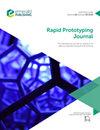Effect of FDM printing patterns on mechanical properties of ABS
IF 3.6
4区 工程技术
Q1 ENGINEERING, MECHANICAL
引用次数: 0
Abstract
Purpose The purpose of this study is to investigate how the amount of material used and printing parameters affect the mechanical and water sorption properties of acrylonitrile butadiene styrene printed parts. Design/methodology/approach The specimens were printed using different printing parameters such as shell number, infill pattern and printing orientation, while accounting for the amount of material used. The mechanical properties of the printed parts were then evaluated using tensile, compression and flexural tests, along with sorption tests. Findings The results revealed that the maximum tensile stress of 31.41 MPa was obtained when using 100% infill and a horizontal printing orientation. Similarly, the maximum flexural strength and compression of 40.5 MPa and 100.7 MPa, respectively, were obtained with 100% infill. The printing orientation was found to have a greater impact on mechanical behavior compared to the number of shells or infill patterns. Specifically, the horizontal printing orientation resulted in specimens with at least 25% greater strength compared to the vertical printing orientation. Furthermore, the relationship between the amount of material used and strength was evident in the tensile and flexural tests, which showed a close correlation between the two. Originality/value This study’s originality lies in its focus on optimizing the amount of material used to achieve the best strength-to-mass ratio and negligible water infiltration. The findings showed that specimens with two shells and a 60% infill density exhibited the best strength-to-mass ratio.FDM印刷模式对ABS机械性能的影响
目的研究材料用量和印刷参数对丙烯腈-丁二烯-苯乙烯印刷件力学性能和吸水性能的影响。设计/方法/方法使用不同的打印参数打印样本,如外壳编号、填充图案和打印方向,同时考虑使用的材料量。然后使用拉伸、压缩和弯曲测试以及吸附测试来评估印刷零件的机械性能。结果表明,最大拉应力为31.41 当使用100%填充物和水平印刷取向时获得MPa。同样,最大弯曲强度和压缩40.5 MPa和100.7 在100%填充的情况下分别获得MPa。与壳或填充图案的数量相比,打印方向对机械行为的影响更大。具体地说,与垂直印刷方向相比,水平印刷方向导致试样具有至少25%以上的强度。此外,在拉伸和弯曲试验中,材料用量与强度之间的关系是明显的,这表明两者之间有密切的相关性。独创性/价值这项研究的独创性在于它专注于优化材料的用量,以实现最佳的强度与质量比和可忽略的水渗透。研究结果表明,具有两个壳体和60%填充密度的试样表现出最佳的强度质量比。
本文章由计算机程序翻译,如有差异,请以英文原文为准。
求助全文
约1分钟内获得全文
求助全文
来源期刊

Rapid Prototyping Journal
工程技术-材料科学:综合
CiteScore
8.30
自引率
10.30%
发文量
137
审稿时长
4.6 months
期刊介绍:
Rapid Prototyping Journal concentrates on development in a manufacturing environment but covers applications in other areas, such as medicine and construction. All papers published in this field are scattered over a wide range of international publications, none of which actually specializes in this particular discipline, this journal is a vital resource for anyone involved in additive manufacturing. It draws together important refereed papers on all aspects of AM from distinguished sources all over the world, to give a truly international perspective on this dynamic and exciting area.
-Benchmarking – certification and qualification in AM-
Mass customisation in AM-
Design for AM-
Materials aspects-
Reviews of processes/applications-
CAD and other software aspects-
Enhancement of existing processes-
Integration with design process-
Management implications-
New AM processes-
Novel applications of AM parts-
AM for tooling-
Medical applications-
Reverse engineering in relation to AM-
Additive & Subtractive hybrid manufacturing-
Industrialisation
 求助内容:
求助内容: 应助结果提醒方式:
应助结果提醒方式:


